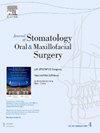Assessment of salivary and serum leptin in tobacco smokers and oral squamous cell carcinoma-A case-control study
IF 1.8
3区 医学
Q2 DENTISTRY, ORAL SURGERY & MEDICINE
Journal of Stomatology Oral and Maxillofacial Surgery
Pub Date : 2024-10-02
DOI:10.1016/j.jormas.2024.102108
引用次数: 0
Abstract
Objectives
Oral squamous cell carcinoma (OSCC) is the most common head and neck malignancy and tobacco-related cancers account for a significant portion of all oral cancers. Cancer patients often suffer from cachexia, which contributes significantly to mortality. Leptin is a protein released by adipocytes identified to play an important role in obesity and inflammation. The present study aimed to quantify and compare salivary and serum leptin in tobacco smokers and OSCC.
Materials and Methods
The present prospective case-control study enrolled 42 subjects divided equally among OSCC and tobacco smokers without oral lesions (TS). Both saliva and blood were collected from each subject and leptin levels were determined using enzyme-linked immunosorbent assay. The data obtained were analysed using Mann Whitney U, Kruskal Wallis, Friedman, and Spearman correlation tests (p < 0.05).
Results
A significant reduction in both salivary and serum leptin levels in OSCC was observed (p < 0.001, 0.002 respectively). In addition, significant reductions in weight and body mass index were also observed during follow-ups at 3, 6, and 9 months (p < 0.001 for both).
Conclusions
Reduced salivary and serum leptin levels in OSCC proved that it is an important diagnostic marker, with non-invasive saliva measurement being more patient-friendly. Future multicentric studies with higher samples in OSCC subgroups are warranted.
Clinical Relevance
Leptin reduction in oral squamous cell carcinoma proved to be an important diagnostic marker. Non-invasive salivary techniques could be employed in mass screening programmes. The significant correlation between leptin and BMI also shed insight into the overall well-being of the patient.
评估吸烟者唾液和血清瘦素与口腔鳞状细胞癌的病例对照研究
目标:口腔鳞状细胞癌(OSCC)是最常见的头颈部恶性肿瘤:口腔鳞状细胞癌(OSCC)是最常见的头颈部恶性肿瘤,与烟草有关的癌症在所有口腔癌中占很大比例。癌症患者通常会出现恶病质,这在很大程度上会增加患者的死亡率。瘦素是脂肪细胞释放的一种蛋白质,已被确认在肥胖和炎症中发挥重要作用。本研究旨在量化和比较烟草吸烟者和 OSCC 患者的唾液和血清瘦素:本前瞻性病例对照研究共招募了 42 名受试者,其中 OSCC 和无口腔病变(TS)的吸烟者各占一半。研究人员收集了每位受试者的唾液和血液,并使用酶联免疫吸附法测定了瘦素水平。所得数据采用 Mann Whitney U、Kruskal Wallis、Friedman 和 Spearman 相关性检验进行分析(P < .05):结果:在 OSCC 中观察到唾液和血清瘦素水平均明显降低(p结论:唾液和血清瘦素水平的降低与 OSCC 的发病有关:OSCC患者唾液和血清瘦素水平的降低证明,瘦素是一种重要的诊断指标,无创唾液测量对患者更友好。未来有必要对 OSCC 亚组进行更多样本的多中心研究:临床相关性:事实证明,口腔鳞状细胞癌中的瘦素减少是一个重要的诊断指标。非侵入性唾液技术可用于大规模筛查计划。瘦素与体重指数(BMI)之间的显着相关性也有助于了解患者的总体健康状况。
本文章由计算机程序翻译,如有差异,请以英文原文为准。
求助全文
约1分钟内获得全文
求助全文
来源期刊

Journal of Stomatology Oral and Maxillofacial Surgery
Surgery, Dentistry, Oral Surgery and Medicine, Otorhinolaryngology and Facial Plastic Surgery
CiteScore
2.30
自引率
9.10%
发文量
0
审稿时长
23 days
 求助内容:
求助内容: 应助结果提醒方式:
应助结果提醒方式:


